#solar panel shade structure
Explore tagged Tumblr posts
Text
Immortal Metals

Website: https://immortalmetals.com/
Address: 10410 66th St N Unit 2, Pinellas Park, Florida 33781, USA
Immortal Metals, a family-owned business led by Travis and Adelyn, specializes in custom metal fabrication and welding. With over 18 years of experience, they offer a range of services for residential, commercial, and industrial needs, including custom metal structures, welding, machining solutions, and heavy machinery repair. Their commitment to quality craftsmanship and personalized service makes them a prominent choice in Pinellas County, Florida.
Facebook: https://www.facebook.com/immortalmetalswelding
Instagram: https://www.instagram.com/immortalmetalswelding/
Linkedin: https://www.linkedin.com/company/immortalmetals/
Keywords:
welding services near me
sheet metal fabrication near me
metal polishing near me
custom metal fabrication near me
solar panel structure
heavy equipment repair near me
custom metal fabrication
machinery repair services
solar panel mounting structure
custom sheet metal fabrication
sheet metal custom fabrication
metal polish service
welding repair services
custom machined parts
welding repair services near me
solar panel shade structure
welding inspection services
complete welding services
welding and fabrication services
professional welder near me
welding mobile services
industrial welding projects
quality custom metal fabrication
heavy machinery repair near me
custom metal art fabrication
solar panel base structure
custom welding services
commercial metal buildings near me
custom welding fabrication near me
metal building repair service
custom metal fabrication services
solar panel carport structure
welding consultancy services
custom welding solutions
custom metal box fabrication
solar panel frame structure
solar panel internal structure
metal door repair services
metal roof repair services
commercial metal shade structures
quality sheet metal fabrication
mil spec welding
custom arc welding services
custom metal fabrication pinellas park
custom works metal fabrication
welding and brazing services near me
machining solutions near me
metal door repair services near me
metal gate repair services
metal shear repair service near me
heavy equipment machinery repair
heavy machinery mobile repair
customized auxiliary welding solutions
machining solutions pinellas park
commercial metal buildings pinellas park
robotic machine fabrication near me
flame cutting services near
unique metal projects
metalwork for residential projects
metal drilling service near me
mil spec welding service price
heavy machinery and equipment repair near me
heavy machinery and equipment repair pinellas park
high quality steel structures service
custom welding rates
custom metal structures service
custom steelwork
#welding services near me#sheet metal fabrication near me#metal polishing near me#custom metal fabrication near me#solar panel structure#heavy equipment repair near me#custom metal fabrication#machinery repair services#solar panel mounting structure#custom sheet metal fabrication#sheet metal custom fabrication#metal polish service#welding repair services#custom machined parts#welding repair services near me#solar panel shade structure#welding inspection services#complete welding services#welding and fabrication services#professional welder near me#welding mobile services#industrial welding projects#quality custom metal fabrication#heavy machinery repair near me#custom metal art fabrication#solar panel base structure#custom welding services#commercial metal buildings near me#custom welding fabrication near me#metal building repair service
1 note
·
View note
Text

This photo contains both flight (flat in the foreground) and qualification assembly (upright in the background) versions of the Solar Array Sun Shield for NASA’s Nancy Grace Roman Space Telescope. These panels will both shade the mission’s instruments and power the observatory.
Double Vision: Why Do Spacecraft Have Twin Parts?
Seeing double? You’re looking at our Nancy Grace Roman Space Telescope’s Solar Array Sun Shield laying flat in pieces in the foreground, and its test version connected and standing upright in the back. The Sun shield will do exactly what it sounds like –– shade the observatory –– and also collect sunlight for energy to power Roman.
These solar panels are twins, just like several of Roman’s other major components. Only one set will actually fly in space as part of the Roman spacecraft…so why do we need two?
Sometimes engineers do major tests to simulate launch and space conditions on a spare. That way, they don’t risk damaging the one that will go on the observatory. It also saves time because the team can do all the testing on the spare while building up the flight version. In the Sun shield’s case, that means fitting the flight version with solar cells and eventually getting the panels integrated onto the spacecraft.
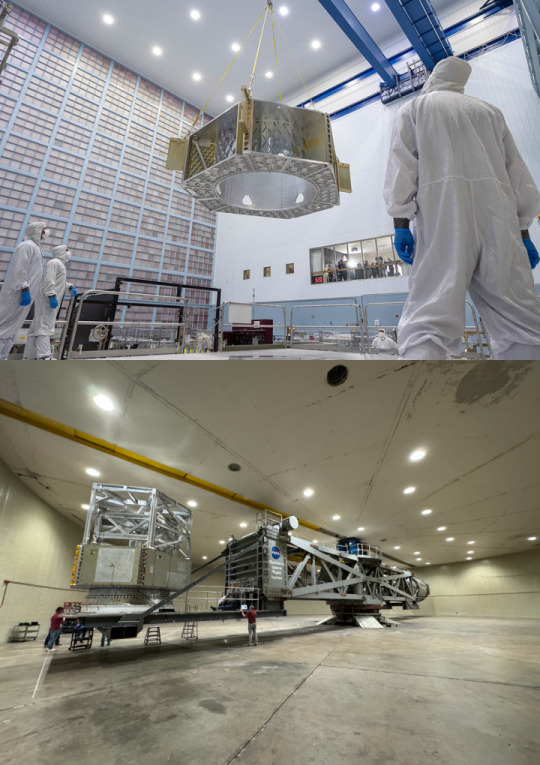
Our Nancy Grace Roman Space Telescope's primary structure (also called the spacecraft bus) moves into the big clean room at our Goddard Space Flight Center (top). While engineers integrate other components onto the spacecraft bus in the clean room, the engineering test unit (also called the structural verification unit) undergoes testing in the centrifuge at Goddard. The centrifuge spins space hardware to ensure it will hold up against the forces of launch.
Engineers at our Goddard Space Flight Center recently tested the Solar Array Sun Shield qualification assembly in a thermal vacuum chamber, which simulates the hot and cold temperatures and low-pressure environment that the panels will experience in space. And since the panels will be stowed for launch, the team practiced deploying them in space-like conditions. They passed all the tests with flying colors!
The qualification panels will soon pass the testing baton to the flight version. After the flight Solar Array Sun Shield is installed on the Roman spacecraft, the whole spacecraft will go through lots of testing to ensure it will hold up during launch and perform as expected in space.
For more information about the Roman Space Telescope, visit: www.nasa.gov/roman. You can also virtually tour an interactive version of the telescope here.
Make sure to follow us on Tumblr for your regular dose of space!
#NASA#astronomy#telescope#Roman Space Telescope#technology#space#science#tech#twins#engineering#STEM
1K notes
·
View notes
Text
Dandelion News - November 8-14
Like these weekly compilations? Tip me at $kaybarr1735 or check out my Dandelion Doodles!
1. Agrivoltaics for sustainable food, energy and water management in East Africa

“[… C]ertain crops […] thrived under the partial shade provided by solar panels. The shade also helped to reduce water loss through evaporation, leading to more efficient water usage. Additionally, rainwater harvested from the panels could be used to supplement irrigation needs.”
2. The world’s largest wildlife crossing is now standing in California

“The structure crosses a 10-lane freeway and has been built to help protect all sorts of wildlife[….] And it’s not just for fauna: some 5,000 plants grown from seed collected within a five-mile radius have been nurtured in two specially created nurseries. The bridge will be topped with wildflowers, shrubs and native grasses that will also benefit insect populations.”
3. Judge rules the military must cover gender-affirming surgery for members' dependents

“[Judge] Torresen found that [gender-affirming] surgery is indeed medically necessary and that the Defense Department had not shown that any important governmental interest was advanced by denying the coverage.”
4. Social Media Can Boost Caracal Conservation

“The team found that searches on the species doubled after the project [using “social media to educate about the caracal”] launched. […] ”The research demonstrates how a public interest in urban ecology and the global phenomenon of ‘cats on the internet’… can be harnessed to leverage conservation action.””
5. US Labor Board Bans Captive Audience Meetings to Ensure 'Truly Free' Worker Choice

“[T]he National Labor Relations Board on Wednesday ruled that employers cannot force workers to attend anti-union speeches. [… W]orkers will no longer have to take part in so-called "captive audience meetings," which employers often use as a union-busting tool and a form of coercion.”
6. Study links grazing with plant phenology and abundance

“In general, plants where caribou or muskoxen were present experienced earlier green-up and greater abundance later in the growing season. “We're used to thinking of the timing of plant availability as impacting the productivity of grazing animals, but not the reverse," Post said.”
7. Frog populations once decimated by disease mount a major comeback
“"These results provide a rare example of how reintroduction of resistant individuals can allow the landscape-scale recovery of disease-impacted species, and have broad implications for amphibians and many other taxa that are threatened with extinction by novel pathogens."”
8. California Announces Special Session To Protect Trans People

“Newsom’s directive is clear: safeguard reproductive healthcare, support immigrants, and shield LGBTQ+ people from what is viewed as existential threats to civil rights and democratic norms. […] California has a unique opportunity to set the blueprint for other states in resisting a Trump administration[….]”
9. When ‘OK, Boomer’ Means ‘Let’s Go Protest’

“Youth activists across the country recognize the efforts of their eco-minded predecessors and welcome them as mentors, role models, and collaborators in their battle against the climate crisis. […] “The idea that Boomers don’t care, he said, is “just misinformation.””
10. How Aussie Waste Warriors are Redirecting Excess Food to Those in Need

“A growing movement is working to reduce perfectly good food going to waste by redirecting it to homes and charities. [… C]haritable organisations [… are] transforming fresh produce that would otherwise have gone to waste into millions of cooked, nutritious meals for people in need each year.”
November 1-7 news here | (all credit for images and written material can be found at the source linked; I don’t claim credit for anything but curating.)
#hopepunk#good news#nature#solar panels#solar power#agriculture#water conservation#wildlife#native plants#military#us military#gender affirming care#trans rights#big cats#workers rights#unionize#labor rights#muskox#caribou#frogs#reintroduction#conservation#california#gavin newsom#activism#solidarity#food#food waste#food insecurity#us politics
290 notes
·
View notes
Text
There's an old saying, probably from back in the 90s, if not earlier, before the big post-War orbital reinvestment, that laws stop at the Karman Line. Not quite true, but close enough. Technically in orbit you're in international waters, and as such companies can incorporate their stations under the laws of the Lunar Soviet, the Martian Exploratory Committee, or even the Titan Expedition if they want to get around safety regulations. Safety regulation like the one that says people need to experience real, full gravity, not just rotational or accelerational simulation, two years for every year in orbit. I hadn't been ground side in a decade. We were somewhere over I think the American Reclamation Zone, as I left the sled, tethers the only thing holding me to anything as I floated on nothing. A single hand reaching up towards the solar shade of the military satellite the company had been contracted to repair. Somewhere down there I had been born. "Ames?" came Control's reassuring voice, ringing through my company issued implants. "On structure."
"Right," came Control's voice, "don't be enjoying the view. The corporate-military conglom that owns this beast wants the job done right, and unfortunately that means I'm gonna need you to hard-wire into the satellite. Don't have your head down in the clouds."
"My head's always in the dark, Control," I said, working my way hand over hand along the guide-bars towards the access panel. "Why is it unfortunate?"
"Are you there?"
"Yeah," I said, pulling the long connection wire from the company's suit towards the panel, watching the sync happen in my cornea. "Why?"
"You'll see." "Well now," said a new voice, suddenly speak in my head with all the cloying subtlety of a nineteen year old drunk outside a bar, "aren't you just dreammmy."
594 notes
·
View notes
Text
Okay, I just saw a video talking about the concept of black light. Not like a black light, but a light that emits black. It would work like a regular light, but instead of light, it would emit darkness.
So, I started thinking about this concept a little bit more. Why don't we have a black "light"? Obviously, it wouldn't be a light since that's not scientifically possible. But why don't we have the concept of something that is able to suck in light and make an area darker. How would something like that even work?
Well, I came up with an idea. Now, it wouldn't necessarily function as a light. It would act more as a magnet. Sucking in only light. Naturally, my mind jumped straight to a black hole, but black holes suck in everything, not just light. So we need to make a few adjustments.
First, ima state a few tiny facts/problems. 1. This lamp can't work like a traditional magnet since light photons have no charge and negligible mass. 2. This lamp would have to utilize quantum physics because with quantum physics, there is a way to "trap" or channel photons.
So, with quantum manipulation, we are able to use a thing called a quantum blockade, which consists of specially designed structures to control the flow of light. If we can figure out how to get these on a smaller scale (small enough to fit on a lamp shade probably), then we can most likely use this to help attract our light.
Next, we would also have to use cavity trapping. This uses optical cavities to confine protons to small spaces. We can use this to keep our light trapped inside the main power source to keep our lamp running.
This would probably mean we would have to find a way to direct the light towards the cavity in the first place, then trap the light inside the cavity, then convert that light into energy which is a super technical sciency experiment that I don't feel like attempting to understand rn.
Now I'm thinking, for this lamp, it could work similar to solar power. When it is turned on, it can manipulate the light into energy to keep it going. This might be a bit tricky and would probably have to also rely on regular electricity to keep it going since it would run out of light really quickly. So if we wanna stick with the solar power technique, we could probably stick solar panels on the base, and you can just leave the lamp in the sun when you're not using it.
On the note of solar power, we can probably power the main core by trapping the light inside solar panels, and then the solar panels can power the lamp. But it would probably have to combine both solar panels and quantum manipulation, which would honestly change the game with solar powered devices. If solar panels could attract all the light in an area, imagine how much power we would get from that. A single pannel in a well placed field could power a city.
I got off track, but anyway, theatrically, it's possible. But we probably need to make a few more breakthroughs in quantum science before hoping to achieve an anti-light lamp for all you cave dwellers. Also, I would like to propose the brand name "Ton-18" for whoever sees this and decides to start making these. Or really just name the brand after a black hole and I will be happy
Also, take this entire post with a grain of salt, I am but a nerdy 14 year old who is just really obsessed with quantum physics
#imagine getting another light switch added into every building#one that is meant to suck the light out of a room#that would be so cool#although these “lights” would also have to have built in fans to keep them cool#so they don't explode from the heat#cool concepts tho#anyway im gonna go to bed now#science#quantum physics#lamps#scientists of tumblr#i hope someone sees this and decides to make a dcience breakthrough#that would be extra cool#black light#nerd rant#i dont want it to be me tho😅#ill leave this up to yall
7 notes
·
View notes
Text
dreaming and IRL worldbuilding
I’ve been doing some talking about getting into radicalism and how to organize. You can do that first—you have a feeling that things need to change and you just act. At some point though, I think it’s important to start thinking from a longer-term perspective. That's where visioning comes in.
To know how to change the world, we should know what we want it to look like. Solarpunk is a great example of this—giving us aspirational visuals and vistas for how the world could look if we got our shit together. This is what a vision is in a nutshell.
Once we have have an understanding of what we want the world to look like, we have to figure out how to get there. This is where things start to become interesting. To me, values are like guiding principles that we ground our actions in. To come up with values, think about the ethics and principles that are embedded in your vision. If we think about solarpunk, some values that I see are ecological harmony, intersectional feminism, and economic democracy.
When we have our vision and values in place, we can think about the specific things that we want to accomplish. Our goals should be relatively concrete things that we can build strategies around. What are the material changes that you want to happen? What are the specific, tangible things that you can work towards? If it’s too broad (ex: “I want to abolish the commodity form”), then that might be one of the descriptors of your vision.
So, you create a vision → which informs your values → and dictates your goals.
To develop a vision, put on your dreaming goggles. Imagine what the world can look like. Try to engage your senses. What do you see? What do you hear? What does it smell like?
To develop your values, look at that vision, analyze the implied material and social contexts and use those as guiding lights.
To develop your goals, think about the specific things you can work towards, acting within your values, to create fertile ground for your vision to flourish.
To wrap up, I want to walk through a vision of a better world. If you want some homework, you can derive some values and goals from that.
---
As I leave my house for the day, I step out onto a quiet city street. The air is crisp and filled with the scent of freshly bloomed flowers and the subtle aroma of earthy, homegrown herbs. The street is lined with majestic, towering trees, their leaves dancing in the gentle breeze, casting shattered shadows on mosaic sidewalks below.
As I walk along the street, I hear the melodies of birds chirping, flitting from mossy building to wild rooftop. The sound of laughter and lively conversations fills the air, as people gather in community spaces and reclaimed streets.
The buildings themselves are architectural wonders, adorned with solar panels and living walls that burst with vibrant vegetation. They harmoniously blend into the surrounding natural landscape, their design inspired by historical ecological buildings. These buildings are not just structures; they are living organisms, integrated with the ecosystem, providing shade, shelter, and sustenance for both humans and wildlife.
Streets are bustling with activity, but they are not dominated by cars. Instead, it is a pedestrian-friendly space where people of all ages and abilities move freely and safely. Electric trams silently glide by, their sleek design reflecting the beauty of their surroundings.
Local artisans and worker-owners have set up vibrant market stalls, showcasing their handmade creations and locally sourced goods. Vibrant textiles, handcrafted jewelry, and organic produce catch the eye. Neighbors stop to chat, share stories, and exchange ideas.
In the distance, I see a community forest garden, a lush oasis of greenery where residents gather to cultivate their own food. The garden is a testament to space reclaimed by the people, fostering a sense of ownership and connection to the land.
As I continue my walk, I feel a sense of hope and possibility. This city is a testament to the power of collective action and the transformative potential of dreaming and envisioning a better world.
#economics#economy#econ#anti capitalists be like#neoliberal capitalism#late stage capitalism#anti capitalism#capitalism#activism#activist#direct action#solarpunks#solarpunk#praxis#socialism#sociology#social revolution#social justice#social relations#social ecology#organizing#complexity#resist#fight back#organizing 101#radicalization#radicalism#prefigurative politics#politics#storytelling
74 notes
·
View notes
Text

Key portion of Nancy Grace Roman Space Telescope clears thermal vacuum test
A major part of NASA's nearly complete Nancy Grace Roman Space Telescope just passed a lengthy thermal test to ensure it will function properly in the space environment.
"This milestone tees us up to attach the flight solar array sun shield to the outer barrel assembly and deployable aperture cover, which we'll begin this month," said Jack Marshall, who leads integration and testing for these elements at NASA's Goddard Space Flight Center in Greenbelt, Maryland. "Then we'll complete the remaining environmental tests for the flight assembly before moving on to connect Roman's two major assemblies and run the full observatory through testing, and then we'll be ready to launch."
Prior to this thermal testing, technicians integrated Roman's deployable aperture cover, a visor-like sunshade, into the outer barrel assembly, which will house the telescope and instruments, in January, then added test solar panels in March. They moved this whole structure into the Space Environment Simulator test chamber at NASA Goddard in April.
There, it was subjected to the hot and cold temperatures it will experience in space. Next, technicians will join Roman's flight solar panels to the outer barrel assembly and sunshade. Then the structure will undergo a suite of assessments, including a shake test to ensure it can withstand the vibrations experienced during launch.
Meanwhile, Roman's other major portion––the spacecraft and integrated payload assembly, which consists of the telescope, instrument carrier, and two instruments––will undergo its own shake test, along with additional assessments. Technicians will install the lower instrument sun shade and put this half of the observatory through a thermal vacuum test in the Space Environment Simulator.
"The test verifies the instruments will remain at stable operating temperatures even while the sun bakes one side of the observatory and the other is exposed to freezing conditions––all in a vacuum, where heat doesn't flow as readily as it does through air," said Jeremy Perkins, an astrophysicist serving as Roman's observatory integration and test scientist at NASA Goddard. Keeping the instrument temperatures stable ensures their readings will be precise and reliable.
Technicians are on track to connect Roman's two major parts in November, resulting in a complete observatory by the end of the year. Following final tests, Roman is expected to ship to the launch site at NASA's Kennedy Space Center in Florida for launch preparations in summer 2026. Roman remains on schedule for launch by May 2027, with the team aiming for launch as early as fall 2026.
TOP IMAGE; This photo captures the installation of the test solar panels for NASA's Nancy Grace Roman Space Telescope, which took place in March. One panel is lifted in the center of the frame on its way to being attached to the outer barrel assembly at right. The deployable aperture cover is stowed on the front of the outer barrel assembly, and the other half of the observatory––the spacecraft and integrated payload assembly, which consists of the telescope, instrument carrier, and two instruments––appears at the left of the photo. Credit: NASA/Jolearra Tshiteya
LOWER IMAGE: This infographic shows the two major subsystems that make up NASA's Nancy Grace Roman Space Telescope. The subsystems are each undergoing testing prior to being joined together this fall. Credit: NASA's Goddard Space Flight Center

2 notes
·
View notes
Text
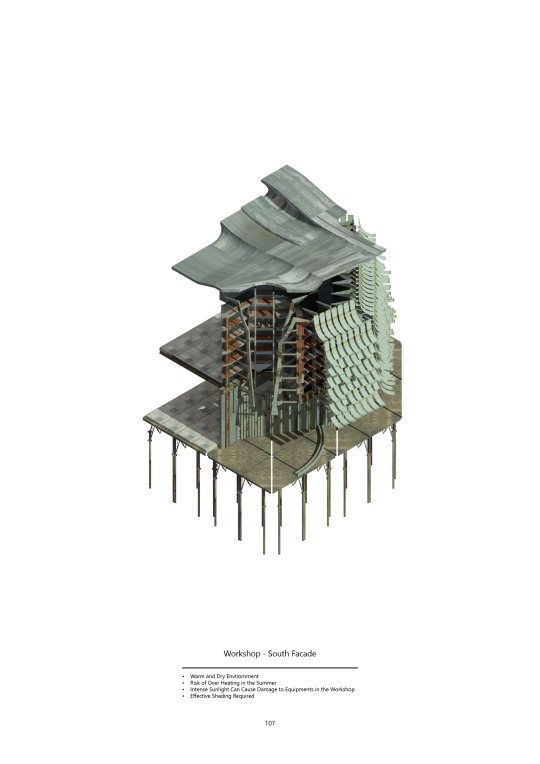
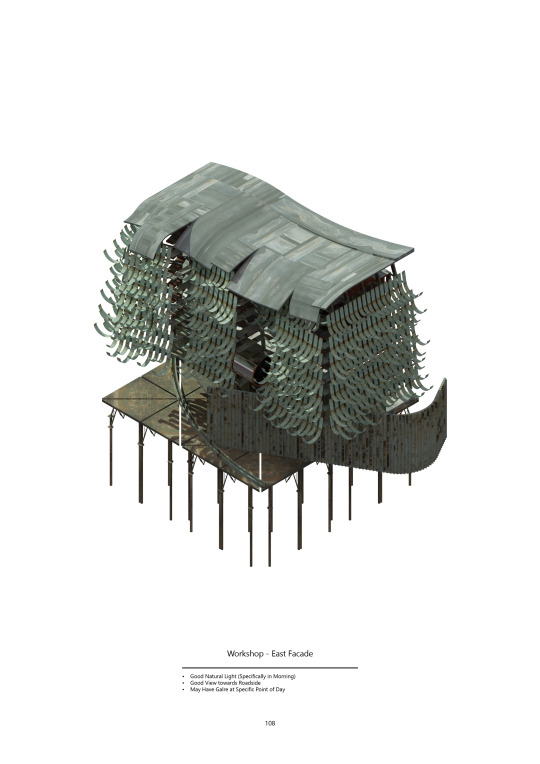
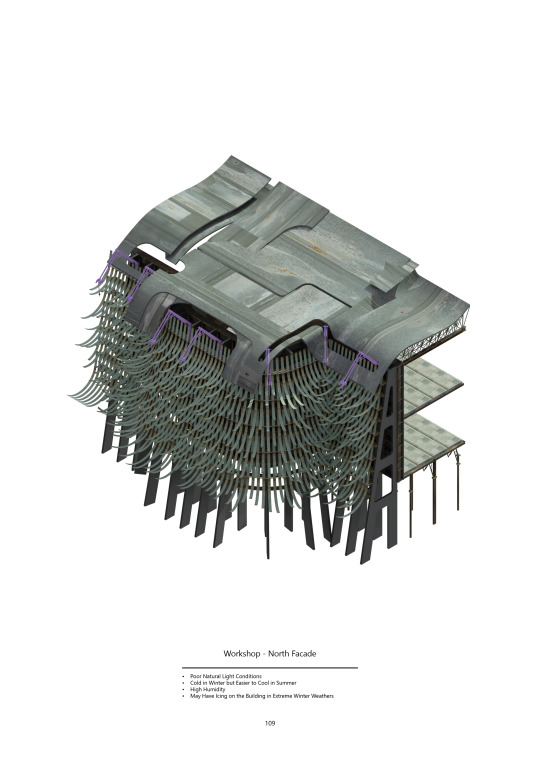
DP2 - Wandering Earth
Week 19:
This week I kept focusing on the workshop by first improving on the plan and then choosing three zones from the plan and designed the roof, facade and structural systems specifically to the environmental conditions required by each zone:
The south facing facade receives the highest level of solar radiation and activities including cutting and drilling take place in this zone, which can lead to overheating in the space, especially at summer. Therefore a layered strategy is implemented on the facade with dense and wide rain-fuel/solar panels acting also as shading devices which can result in effective cooling off the space.
The East Facing Facade provides excellent natural light in the morning and has a good view down the hill towards the city, therefore there are voids on the facades to provide opportunities for a balcony area. The facade panels are more curled up to further provide natural lighting and views as there are workbenches behind the east facade.
The North Facade in 2050 will encounter more severed environmental conditions as it receives poor natural light and is normally cold and damp. Therefore the facade panels are less dense to allow more light entering the space and more gaps on the roof to provide lighting. Deicing systems inspired by the aviation industry extends out from the roof to clean the icing that may form on the facade.
The Roof has different levels and grooves to direct the rainwater to drip down onto the facade elements and utilises its potential energy to regenerate energy; but also recycled into the bathroom to be reused. The roof has a curved shape that rises at certain points for lighting purposes.
I should keep working on these three design modules and use line drawings in combination with these renders to reveal the HVAC, structural and water systems of the space. Doing lighting and heating simulations on the interior space to prove the systems function properly
Key ideas mentioned:
Hollow tiles for heating and ventilation systems running through
shape the tiles so it guides the cool down streaming air around the furniture in the room
Pneumatically designed air exhaustion systems for manufacturing area (Reference to Zaha Science Museum)
Shelving systems on the facade to hang and dry the pieces manufactured in the workshop
Light pipes bringing light to the working area that is integrated with the furniture
furniture suspended from the ground with localized heating, water running through the furniture
Ramps connecting the buildings that extend out into the forest and foreshadowing the theme and emotions that the next building is going to bring to the visitors. Buildings get cut through similarly to canyons.
When presenting, show how spatial organization, facade systems and furniture systems are designed differently according to the hot and cold environment and lux levels.
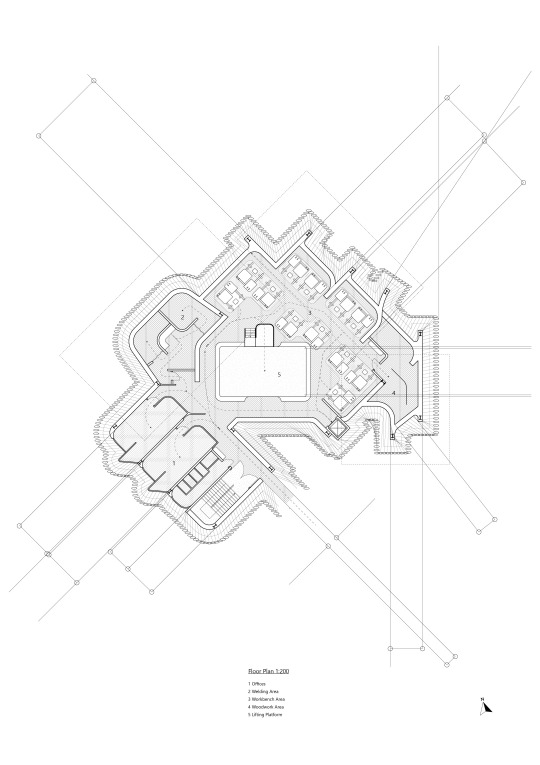
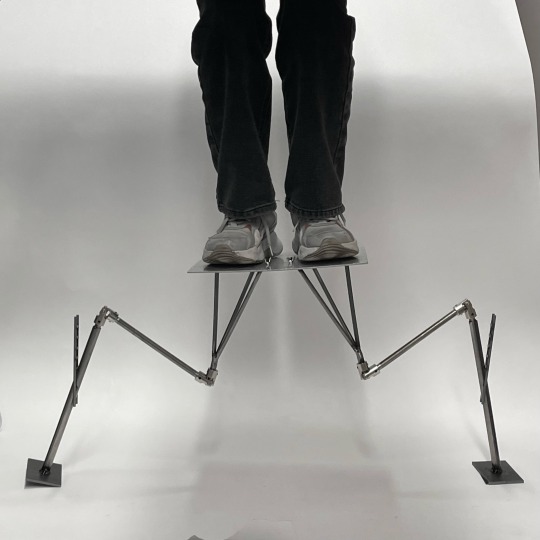
8 notes
·
View notes
Text
WIP: CE Eco-House 001
Published: 7-14-2023 | Updated: 9-22-2023 My current hood is set in a desert landscape, a 24th century SimCity dotted with arcologies and other architectural marvels (if I can finish the builds!) - like this eco-house from Cliff Empire (Lion’s Shade, 2018):
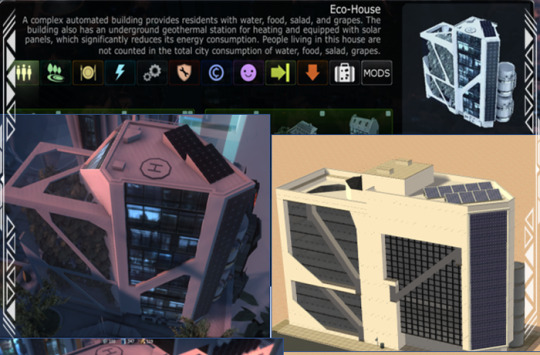
“A complex automated building provides residents with water, food, salad [greens], and grapes [wine]. The building also has an underground geothermal station for heating and is equipped with solar panels, which significantly reduces its energy consumption.”
The structure is tall and straightforward but getting some parts of the exterior frame in place will be a little tricky.
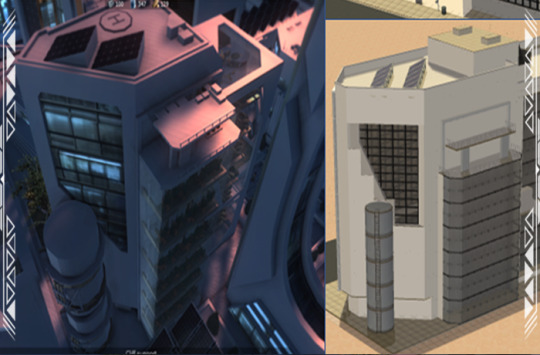
I had to add a custom tint to some windows and make solar walls/floors for this build – they’ll land on this site eventually.
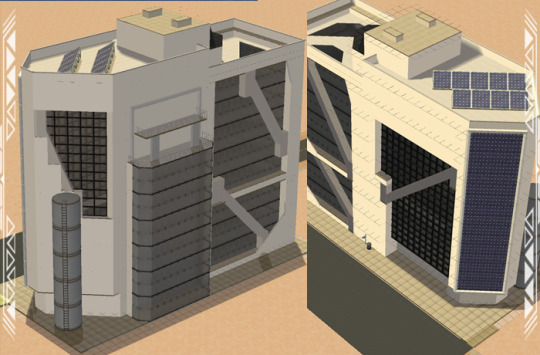
Updating this building will be much easier thanks to the Shift Everything (@lamare-sims, 2022) and Object Freedom 1.02 (@fwaysims, 2023) mods.
CREDITS Sources: Eco-House/Cliff Empire (Lion’s Shade, 2018).
22 notes
·
View notes
Text
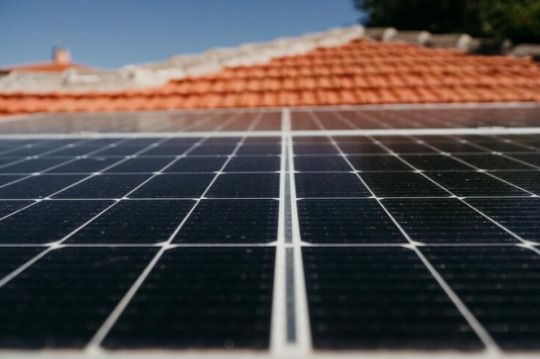
Solar installation at home and panel removal and reinstallations
Solar Installation at Home
1. Assess Your Energy Needs
Calculate your household’s energy consumption to determine the size of the solar system you'll need. Check your utility bills to see your average monthly and annual energy usage.
2. Evaluate Your Home’s Solar Potential
Consider factors such as roof orientation, tilt, shading, and available space. An installer will typically perform a site assessment to determine if your home is suitable for solar panels.
3. Choose the Right Solar System
Grid-Tied Systems: These are connected to the local utility grid and are the most common. They allow you to use grid power when solar production is low and can potentially earn credits through net metering.
Off-Grid Systems: Ideal for remote locations, these systems are not connected to the utility grid and require battery storage.
Hybrid Systems: Combine elements of both grid-tied and off-grid systems, with battery storage to provide backup power.
4. Select a Reputable Installer
Research and compare solar installation companies. Look for certifications, customer reviews, and warranties. Get multiple quotes and ask for detailed proposals.
5. Permits and Approvals
Obtain necessary permits and approvals from local authorities and your utility company. Your installer usually handles this, but it's good to be aware of the requirements.
6. Installation
The installation process typically involves mounting the panels on your roof, wiring them to an inverter, and connecting the system to your home’s electrical system. It usually takes one to three days.
7. Inspection and Activation
After installation, your system will need to be inspected by local authorities and your utility company. Once approved, your system can be activated.
Panel Removal and Reinstallation
1. Reasons for Removal
You might need to remove panels for roof repairs, upgrades, or relocation. Ensure that the removal process is done carefully to avoid damage.
2. Hire Professionals
Removing and reinstalling solar panels should be handled by professionals. They have the expertise to safely disconnect, handle, and reinstall the panels.
3. Roof and System Inspection
Before reinstallation, inspect the roof for any damage and ensure that it’s structurally sound. Also, check the solar system components to ensure they are in good condition.
4. Reinstallation Process
Reinstallation involves re-mounting the panels, reconnecting the wiring, and ensuring the system is properly calibrated and functional.
5. Testing and Activation
Once reinstalled, the system should be tested to ensure everything is working correctly. This includes checking the inverter, connections, and overall performance.
6. Documentation and Updates
Update any system documentation and inform your utility company of the changes, if necessary. This helps ensure your system continues to operate efficiently and in compliance with any agreements.
Additional Tips
Maintenance: Regularly clean your panels and check for any issues. Most systems require minimal maintenance, but it's important to stay on top of it to ensure optimal performance.
Warranty: Keep track of your system’s warranty coverage. Most solar panels come with a 25-year warranty, but other components may have different durations.
Energy Monitoring: Consider installing an energy monitoring system to keep track of your solar energy production and consumption.
If you have specific questions or need more detailed advice, feel free to ask!
#SolarEnergy#RenewableEnergy#GoSolar#CleanEnergy#SolarPower#Sustainability#GreenEnergy#SolarPanel#EnergyEfficiency#SolarInstallation#SaveEnergy#SolarPanels#SolarPV#ClimateAction#SolarSystem#SolarSolutions#SolarElectric#CleanTech#SolarInnovation#HomeSolar
2 notes
·
View notes
Text
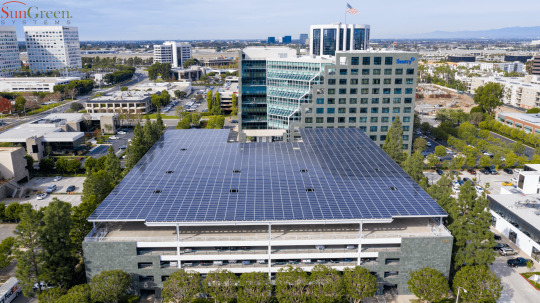


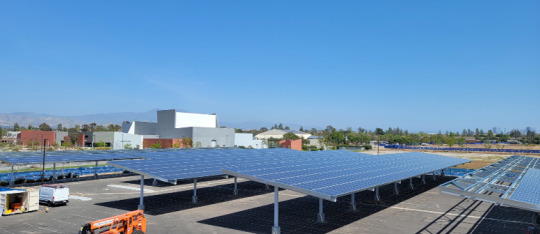

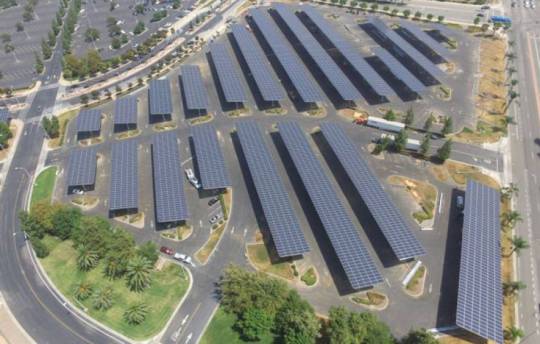


(photos of solar panel covered shade structures over parking lots. The lower right one is being cleaned by workers on a bucket crane using a ginormous hi-tech squeegie.)
Look, now that we've moved beyond the hypothetical, with "new normal" heat waves of 110° for several days in a row, shaded parking places are the best. And they power lots of recharging stations for our plug-ins and EVs .
#little california things#one of my nerdy hobbies#is watching my city becoming encrusted with these things year by year on google maps#like some kind of benevolent kudzu#the schools and colleges started it about ten years ago#and some hospitals and libraries#and now even a little day care center#to the point that when city hall's parking lot was just torn up and renovated to add more spaces#for its adjacent park and sports fields#they removed median strips with tall rows of trees that shaded the spaces#i was upset but figured it must be time for them to add solar panel parking shadss#and i was honestly shocked to see it was just to design a new layout to fit more cars#like yeas we needed that on game days#but how dare you take trees down#and nkt reduce carbon footpring#but accommodate its opposite?#this is the city that prides itself on sustainbility#even the dinky little day care center has solar parking#what gives?
6 notes
·
View notes
Text
Carport Canopies
Carports are a great way to protect your car from the elements. They are easy to install, economical, and can be matched to your house to add a custom look to your property.
The frame of a canopy can be cleaned with a simple soapy water solution, but you should reserve more abrasive cleaning for stubborn stains and mold.
Easy to Assemble
All of ALEKO’s carport canopy packages come with a user manual and all the necessary hardware needed for an easy assembly process. Even the largest model can be assembled by two people in about 6 to 8 hours.
Using galvanized steel and powder-coated pipes, the temporary garage shelter is highly durable and rust resistant. This makes it a great option for outdoor equipment storage, bulk storage, and off-season gear. The carport also features a high-quality PE fabric that protects cars, trucks and equipment from sun exposure and rain.
To assemble the portable metal carport, you simply connect the pipes using T-connectors and angled connectors. You can then add the tarp and use the anchors to secure it to the ground. For best results, ALEKO recommends that you install the anchors in groups of three for added stability. The anchors can be used for either dirt, gravel or asphalt applications. In addition, the portable carports can be placed on concrete bases for additional security.
Affordability
Carport canopies are a great way to keep your vehicle under cover without breaking the bank. They are also very easy to assemble, allowing you to protect your vehicle in no time at all.
When shopping for a new canopy it is important to consider the material used and if the frame has been powder coated. This will help to prevent corrosion and rust on the steel, which will in turn lengthen the lifespan of the structure.
A good option is a portable model that uses galvanized steel and has polycarbonate roofs, which are both very strong and durable. These models will typically have a slightly higher price tag than permanent ones, which can be made from a variety of materials but tend to be sturdier as they do not focus on portability or ease of set up. This is because they are designed to be permanently fixed in position and will often have a higher build quality with thicker materials.
Versatility
A carport can be a very versatile addition to your home. It can protect your vehicles and other belongings from different weather elements, as well as provide a shelter for outdoor activities such as parties and BBQs. It also adds value to your property and can increase its curb appeal.
Carports come in a variety of styles, from those that resemble fully structured shelters to canopy models that look more like large tents. Your specific needs and budget will determine which one is right for you.
The VEVOR carport is a high-quality model that offers a lot of value for the price. Its durable fabric is water- and UV-resistant, making it a great choice for year-round use. Its frame uses patented ShelterLock stabilizers for increased stability, and its Ratchet-Tite cover tensioning system helps to ensure a tight cover and door panel connection. It weighs 134.6 pounds and comes with a one-year limited warranty on the cover fabric and end panels.
Environmentally Friendly
Carport canopies are an environmentally friendly solar energy solution that provides shade and renewable power. They provide a way for businesses and communities to meet their environmental and energy needs while using existing land. The optimum tilt and orientation of the canopy maximizes energy generation, allowing the building to receive payments from the feed-in tariff while saving money on electricity bills.
They also help to reduce greenhouse gas emissions and increase the resilience of the community. The canopy’s photovoltaic cells convert sunlight into electricity and can be used to power buildings, equipment, and lighting. It’s also a great way to demonstrate your commitment to green energy and inspire others to follow suit.
Pyramid Aluminum is an experienced team that can help you select the best canopy for your space. We’ll discuss your vision, take accurate measurements, and engineer your new structure. We will then manufacture and install your new canopy. It will look good, save you money, and be easy to maintain.
youtube
source https://carportscanberra.wordpress.com/2023/07/29/carport-canopies/
3 notes
·
View notes
Text
Solar has such great potential to alleviate climate and energy crises, but destroying pristine wilderness to build solar farms is a stupid and backwards approach.
Solar panels need to be where people are! Not where construction could harm wild ecosystems! They need to be integrated into current structures and planned into future ones.
They could easily be placed on roof tops and on carports. Parking lots could have covered parking with solar panels, providing both shade and protection from inclement weather. Sidewalks and bus stops could have overhead shade/rain cover that could be designed to also collect solar energy. Streets, roads, and freeways could have solar energy collection either alongside or over.
We may need to become creative to integrate more solar energy collection to the structures around us, but it makes more sense to put your energy infrastructure where it's used and needed than to destroy natural habitat in an idiotic greenwashing attempt.
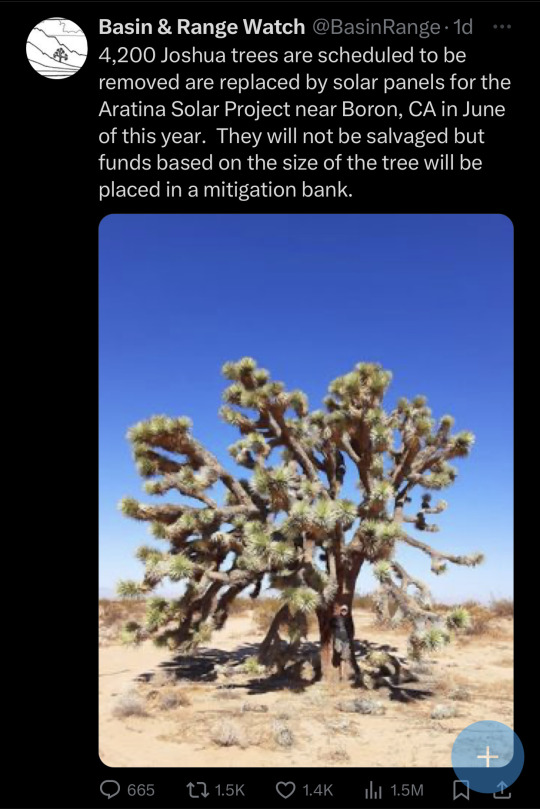
They will destroy nature and call it saving the planet.
40K notes
·
View notes
Text
Powering Progress: The Strategic Advantages of Commercial Solar Power with Vizi
In today's competitive business landscape, efficiency, sustainability, and cost reduction are paramount. For businesses looking to gain a significant edge, commercial solar power is no longer a niche concept but a powerful strategic imperative. From manufacturing facilities and office buildings to retail centers and agricultural operations, the sun offers a scalable and sustainable energy solution that directly impacts the bottom line. At Vizi, we empower businesses to unlock these benefits through expertly designed and installed solar panels commercial systems.
The core principle behind commercial solar power is identical to its residential counterpart: converting sunlight into usable electricity. However, the scale, complexity, and potential benefits are significantly amplified for commercial applications. A typical commercial solar installation involves a larger array of solar panels, more robust inverters, and often more sophisticated monitoring systems to meet the higher energy demands of businesses.
One of the most compelling advantages of integrating solar into your commercial operations is the dramatic reduction in operational costs. Electricity expenses represent a substantial overhead for many businesses. By generating a significant portion, or even all, of your own electricity, you can dramatically reduce or eliminate your monthly utility bills. This provides a predictable cost structure, insulating your business from volatile energy price fluctuations in the market – a valuable hedge in an unpredictable economy.
Beyond direct cost savings, commercial solar power offers a powerful pathway to enhanced sustainability. In an era where consumers and stakeholders are increasingly prioritizing environmentally responsible businesses, adopting solar panels commercial demonstrably showcases your commitment to reducing your carbon footprint. This not only improves your corporate social responsibility (CSR) profile but can also attract environmentally conscious customers and talent, bolstering your brand image and market competitiveness. Many companies now proudly highlight their renewable energy initiatives as a key differentiator.
The financial incentives for commercial solar are also substantial. Governments at various levels often offer a range of tax credits, depreciation benefits (such as accelerated depreciation), and grants designed to encourage businesses to invest in renewable energy. These incentives can significantly offset the initial capital outlay, leading to a faster return on investment (ROI). Vizi has extensive experience navigating these complex incentive programs and can help your business maximize the financial benefits of your solar investment.
Furthermore, a well-implemented commercial solar system can provide energy independence and resilience. In some regions, power outages can disrupt operations and lead to significant financial losses. While a grid-tied solar system won't completely eliminate the risk of outages without battery storage, it can reduce your reliance on the grid and, with the addition of energy storage solutions, provide critical backup power during disruptions. This enhanced reliability translates directly into business continuity.
The installation of solar panels commercial by Vizi is a comprehensive process, tailored to the unique needs of each business. We begin with a thorough energy audit and site assessment, analyzing your current energy consumption, roof structure, available land (for ground-mounted systems), and shading factors. Our team of engineers then designs a custom solar solution optimized for your specific energy demands and operational goals. This includes selecting the most efficient solar panels, inverters, and mounting systems.
Vizi manages the entire project lifecycle, from initial design and permitting to procurement, installation, and commissioning. Our certified technicians ensure that the installation adheres to the highest safety standards and complies with all local and national building codes. Post-installation, we offer comprehensive monitoring and maintenance services to ensure your solar system operates at peak efficiency for decades to come.
Investing in commercial solar power with Vizi is more than just an energy upgrade; it's a strategic investment in your business's future. It's about achieving long-term cost savings, enhancing your brand reputation, meeting sustainability goals, and building a more resilient operation. Let Vizi be your partner in powering progress – contact us today to explore how a custom commercial solar solution can transform your business.
0 notes
Text
Can a Patio Enclosure Be Used Year-Round?
If you love spending time outdoors, you might wonder if patio enclosures can be used year-round. Whether you're dealing with summer heat, winter chill, or unpredictable weather, the right enclosure can make your outdoor space comfortable in any season. Let’s explore how to create a patio enclosure that suits your needs all year.
What Are Patio Enclosures?
Patio enclosures are structures designed to extend your living space by providing a protected outdoor area. They come in various styles, from screened enclosures to glass-walled sunrooms. Depending on the design, they can shield your patio from wind, rain, snow, and excessive sunlight, allowing you to enjoy your outdoor space no matter the season.
How Patio Enclosures Enhance Year-Round Comfort
A well-designed patio enclosure offers year-round usability, protecting from the elements while maintaining an open, outdoor feel. Here’s how different seasons affect your enclosed patio and what you can do to stay comfortable:
Spring: Enjoy the Fresh Air Without the Pollen
A screened-in patio enclosure keeps out pollen, allowing you to enjoy springtime breezes without allergy flare-ups.
Retractable screens or windows can help you adjust airflow and temperature for optimal comfort.
Adding ceiling fans or adjustable vents improves ventilation on warmer days.
Summer: Beat the Heat While Staying Outdoors
Tinted or UV-resistant glass can reduce heat buildup and protect furniture from sun damage.
Ceiling fans, portable AC units, or misting systems can help maintain a cool environment.
Solar shades or blackout curtains can provide extra shade and prevent excessive heat.
Fall: Enjoy Crisp Evenings Without the Chill
Insulated panels and enclosed glass structures help retain heat during cooler evenings.
A patio heater or electric fireplace can keep the space cozy.
Weatherproof furniture and rugs add warmth and comfort to your patio enclosure, enhancing its overall appeal.
Winter: Stay Cozy Without the Cold
Insulated glass or vinyl panels help block cold winds while allowing natural light to enter.
Space heaters, radiant floor heating, or a small wood-burning stove can make the space comfortable.
Heavy-duty weather stripping and insulated doors prevent drafts and heat loss.
Types of Patio Enclosures for Year-round Use
Screened-In Patios
Ideal for spring and summer, this product offers excellent ventilation while keeping bugs and debris out.
Roll-down vinyl panels or clear plastic curtains can be enhanced for added weather protection in colder months.
Three-Season Rooms
Typically enclosed with glass or acrylic panels, allowing for use in spring, summer, and fall.
It is not fully insulated, but can still be used in mild winter climates with added heating options.
Four-Season Sunrooms
Fully insulated and designed for year-round comfort.
Features energy-efficient windows and climate control systems for seamless indoor-outdoor living.
Tips for Making Your Patio Enclosure More Comfortable Year-Round
Choose the Right Materials: Insulated glass, weatherproof panels, and UV-resistant screens improve durability and climate control.
Invest in Proper Ventilation: Ceiling fans, exhaust vents, and sliding windows allow airflow regulation.
Incorporate Heating and Cooling Solutions: Portable heaters, air conditioning units, and ceiling fans can enhance comfort.
Use weather-resistant furniture and décor: outdoor rugs, all-season cushions, and weatherproof furniture ensure longevity and comfort.
A year-round patio enclosure is a worthwhile investment yeah. An ar-round patio enclosure is a valuable investment to extend your outdoors. You can transform your patio into a comfortable retreat in any season with the right design, materials, and climate control options.
Ready to create the perfect outdoor space? Visit Screen Mobile of South Bend to explore custom patio enclosures and outdoor/indoor screen solutions. Make your patio a comfortable and stylish extension of your home, no matter the season!
0 notes
Text


Solar panels for NASA’s Roman Space Telescope pass key tests
NASA’s Nancy Grace Roman Space Telescope’s Solar Array Sun Shield has successfully completed recent tests, signaling that the assembly is on track to be completed on schedule. The panels are designed to power and shade the observatory, enabling all the mission’s observations and helping keep the instruments cool.
The Roman team has two sets of these panels –– one that will fly aboard the observatory and another as a test structure, used specifically for preliminary assessments.
Engineers at NASA’s Goddard Space Flight Center in Greenbelt, Maryland, evaluated the test version in a thermal vacuum chamber, which simulates the hot and cold temperatures and low-pressure environment the flight panels will experience in space. Since the panels will be stowed for launch, the team practiced deploying them in space-like conditions.
Meanwhile, a vendor built up the flight version by fitting the panels with solar cells. After delivery to Goddard, technicians tested the solar cells by flashing the panels with a bright light that simulates the Sun.
“We save a significant amount of time and money by using two versions of the panels, because we can do a lot of preliminary tests on a spare while moving further in the process with the flight version,” said Jack Marshall, the Solar Array Sun Shield lead at NASA Goddard. “It streamlines the process and also avoids risking damage to the panels that will go on the observatory, should testing reveal a flaw.”
Next spring, the flight version of the Solar Array Sun Shield will be installed on the Roman spacecraft. Then, the whole spacecraft will go through thorough testing to ensure it will hold up during launch and perform as expected in space.
TOP IMAGE: The solar panels for NASA's Nancy Grace Roman Space Telescope are undergoing assessment in a test chamber at the agency's Goddard Space Flight Center in this photo. Credit NASA/Chris Gunn
LOWER IMAGE: Both versions of the Solar Array Sun Shield for NASA’s Nancy Grace Roman Space Telescope appear in this photo, taken in the largest clean room at NASA’s Goddard Space Flight Center. The flight version lies flat in the foreground, while the qualification assembly stands upright in the background. The flight panels will shade the mission’s instruments and power the observatory. Credit NASA/Chris Gunn
6 notes
·
View notes